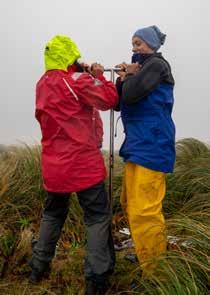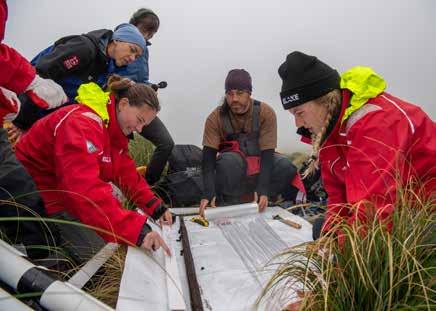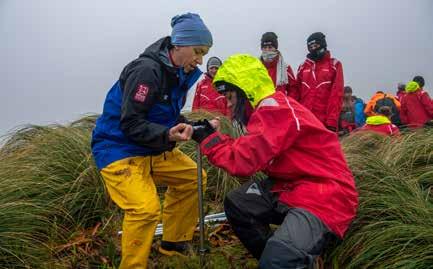
3 minute read
MUD, KELP AND PLANKTON
“We are sampling peat to look at the changes in the westerly winds through the sediment layers,” said Ankia Van Zyl, from Auckland.
“We also collected plankton from the back of HMNZS CANTERBURY to look at environmental DNA so it’s possible to detect the presence of something like a marine pest without actually have to visibly observe, by which point it might be too late to do anything about it.”
Lara Teodoresdu, also from Auckland, said sampling kelp would assist research being carried out in Antarctica.
“It wasn’t what I expected,” Ankia said. “I always thought Navy food wouldn’t be very good, like a pot of gruel or soup. But we got here and it was a whole buffet and everything was just so yummy.”
The students and teachers also took part in PT on the flight deck, kapa haka practice and psyche briefings.
Freya High, from Nelson, said she was impressed how everything was really ordered and structured but everyone is really supportive and friendly. “I really had a good time.”
It also helped that sea conditions were calm for the trip.
That was the comment made as students braved wind and wet on one of New Zealand’s most windswept outer islands as part of Operation Endurance in February.
The Sir Peter Blake Trust’s environmental leadership expedition included 11 students and five teachers taking part in scientific research with scientists from the University of Otago, GNS Science and the Cawthron Institute.
In two days they managed to take a 3.3-metre deep peat core sample in the mist of Campbell Island’s Col Lyall Saddle, within sight of nesting albatrosses, and collected plankton and kelp samples from the waters of Perseverance Harbour.

“In the past couple of years they have noticed some kelp wash up on the shores of Antarctica. And so it drifts around the continent [via the Antarctic circumpolar current] and onto the Antarctic Peninsula.
Campbell Island sits in the path of the Antarctic circumpolar current, which is driven by strong westerly winds.
“We are looking at the kelp on the shores here and testing it to see if the microbes and pathogens can be transported on kelp rafts across the Southern Ocean.”
The pair thoroughly enjoyed their five-day expedition on HMNZS CANTERBURY, their first time aboard a Navy ship.
“The people have been amazing and really interesting. The sailors too, they are just all so welcoming.
The catering aboard CANTERBURY proved a surprise.
“They hyped it up to be really swelly and we thought it would be horrible, but it was really calm. It was kinda disappointing, but I don’t think we would be disappointed if it was really swelly.”
She was in her element when she got to the peat sampling.
“It’s amazing how much information you can get from a little bit of mud.”
The Sir Peter Blake Trust has been accompanying Navy ships to New Zealand’s outer islands for more than 10 years. The first was 2012 on Op Havre aboard CANTERBURY and also in 2014, and 2016 (aboard Offshore Patrol Vessels), 2018 and then this year.
Blake Head of Programmes Jacob Anderson said their truncated work programme shows how much you can do in one day.
“It was great to complete the plankton tows in Perseverance Harbour, collect kelp samples and get one peat core. We would have loved to have collected peat from the Mt Honey site, but we managed to get one peat core from Col Lyall Saddle.” Layers of peat contain information about the vegetation and climate when it was deposited.
“The peat collected from Campbell Island can be used to understand how the changing strength of westerly winds have influenced rainfall patterns, and how heat and gases (such as carbon dioxide) are exchanged between the ocean and atmosphere.


The students also enjoyed sitting down and grilling Commander Heslop for more than an hour on the Embarked Forces Recreation Room couches.
“To chat with the CO, to get her insight and leadership style for the group, all the experiences on the ship are as valuable as the science education,” Mr Anderson said.
“Everyone’s really enjoyed their time on the ship.
“The students have fully embraced all the different opportunities and all of the ship’s company to learn from them as well.
“More than anything, they’ve realised that plans change. Right from the start. You have to have an element of flexibility and that’s one aspect of operating on a ship like this.”









